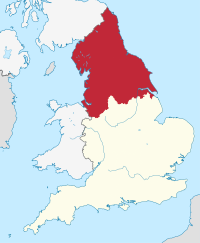
Back Noord-Engeland Afrikaans إنجلترا الشمالية Arabic উত্তর ইংল্যান্ড Bengali/Bangla Nord d'Anglaterra Catalan Nordengland Danish Nordengland German Norda Anglio Esperanto Norte de Inglaterra Spanish Iparraldeko Ingalaterra Basque انگلستان شمالی Persian
Northern England
North of England / the North | |
|---|---|
 The three current Northern England statistical regions combined shown within England. Other definitions of the North vary and have changed over time. | |
| Sovereign state | |
| Constituent country | |
| Regions | North East England • North West England • Yorkshire & The Humber |
| Counties |
|
| Devolved regions | |
| 10 largest settlements in order of population | |
| Area | |
• Total | 37,331 km2 (14,414 sq mi) |
| Population (2011 census)[1] | |
• Total | 14,933,000 |
| • Density | 400/km2 (1,000/sq mi) |
| • Urban | 12,782,940 |
| • Rural | 2,150,060 |
| Demonym | Northerner |
| Time zone | GMT (UTC) |
| • Summer (DST) | UTC+1 (BST) |
Northern England, or the North of England, is a region that forms the northern part of England and mainly corresponds to the historic counties of Cheshire, Cumberland, Durham, Lancashire, Northumberland, Westmorland and Yorkshire.[2][3] The region also coincides with the medieval era borders of Anglian Northumbria, the Anglo-Scandinavian Kingdom of Jorvik, and the Brythonic Celtic Hen Ogledd kingdoms.
The North is a grouping of three statistical regions: the North East, the North West, and Yorkshire and the Humber. These had a combined population of 15.5 million at the 2021 census,[4] an area of 37,331 km2 (14,414 square miles) and 17 cities.
Northern England is culturally and economically distinct from both the Midlands and Southern England. The area's northern boundary is the border with Scotland, its western the Irish Sea and a short border with Wales, and its eastern the North Sea. Its southern border is often debated, and there has been controversy in defining what geographies or cultures precisely constitute the 'North of England' — if, indeed, it exists as a coherent entity at all.
Many Industrial Revolution innovations began in Northern England, and its cities were the crucibles of many of the political changes that accompanied this social upheaval, from trade unionism to Manchester Liberalism. In the late 19th and early 20th centuries, the economy of the North was dominated by heavy industry. Centuries of immigration, invasion, and labour have shaped Northern England's culture, and it has retained countless distinctive accents and dialects, music, arts, and cuisine. Industrial decline in the second half of the 20th century damaged the North, leading to greater deprivation than in the South. Although urban renewal projects and the transition to a service economy have resulted in strong economic growth in parts of the North, the North–South divide remains in both the economy and culture of England.
- ^ Compton, Garnett (21 March 2013). "2011 Census: Population Estimates by five-year age bands, and Household Estimates, for Local Authorities in the United Kingdom". Office of National Statistics. Retrieved 15 May 2017.
- ^ "Publications catalogue | British History Online". archive.british-history.ac.uk. Retrieved 31 July 2024.
Sources relating to the historic counties of Cheshire, Cumberland, Durham, Lancashire, Northumberland, Westmorland and Yorkshire.
- ^ https://britishcountyflags.com/wp-content/uploads/2020/02/the-problem-of-e2809ccounty-confusione2809d-e28093-and-how-to-resolve-it-1.pdf [bare URL PDF]
- ^ Park, Neil (21 December 2022). "Estimates of the population for the UK, England, Wales, Scotland and Northern Ireland". Office for National Statistics. Retrieved 25 August 2023.